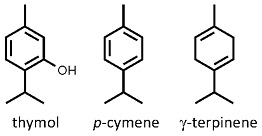 Trachyspermum ammi
Trachyspermum ammi
ajowan • carom
Back to “Spices: ajowan, ajwain, bishop’s weed (Trachyspermum ammi)fr”
Trachyspermum ammi L. [= T. copticum (L.) Link] (Apiaceae); ajowan (Afrikaans); netch azmud (Amharic); ajwan (Arabic); xi ye cao guo quin (Chinese); ajouan (French); Ägyptischer Kümmel, Indischer Kümmel (German); ajowan (Hindi); ajowan (Italian); jintan (Malay); ajowan (Spanish); phak chi (Thai)
DESCRIPTION The small fruits (“carom seeds”) are up to 2 mm (0.08 in.) long, broadly ovoid and conspicuously warty. They have a bitter, slightly pungent, spicy taste and a strong aroma similar to that of thyme.
THE PLANT An annual with an erect stem, compound, feathery leaves and white florets arranged in flat-topped umbels.2 A second species, also used as a spice, is ajmud (T. roxburghianum). The small fruits of both species resemble those of celery, so that they are often confused or substituted with one another or with celery.
ORIGIN Ajowan is a cultigen of unknown origin, perhaps developed in Egypt or Ethiopia.1 It is used in a broad region that stretches from Ethiopia and Egypt through the Arabian Peninsula to Afghanistan, Pakistan and India. Recorded names include ajowan, carom, bishop’s weed, ajwain, omam, Ethiopian caraway, white cumin and netch azmud in Amharic.3 It should not be confused with true ajmud (T. roxburghianum) from South Asia, Southeast Asia and Indonesia.1 Ajmud is also known as ajmod in Hindi and Urdu, ajamoda or ajamodika in Sanskrit, radhuni in Bengali and kant-balu in Burmese.
CULTIVATION Ajowan is grown from seeds as a short-lived annual crop. It is adapted to warm and dry conditions and does not survive waterlogging or frost. Ajmud has similar horticultural requirements.
HARVESTING Flowering stalks are collected by hand when the fruits start to mature and are spread out in the sun to dry. The fruits are collected and cleaned, often by sieving and winnowing.
CULINARY USES Ajowan has a powerful aroma and is therefore used sparingly as a spice and condiment. It is appreciated in Indian, Middle Eastern and North African cooking, especially in curry dishes, bean dishes, pickles and chutneys. It is added to or sprinkled on the popular Indian poppadum and other types of breads and biscuits. In Ethiopia and Eritrea, it is an essential ingredient of the hot chilli spice mixture known as berbere (in which it is said to reduce and balance the hotness). It is also used to flavour non-pungent sauces, butter and katikala, an Ethiopian alcoholic drink.3 Ajmud is used in spice mixtures and pickles and may replace mustard seeds as one of the five ingredients in a localised version of Bengali panch phoron. It is typically tempered in hot oil before use.
FLAVOUR COMPOUNDS The characteristic thyme-like flavour is due to the presence of thymol as the dominant compound in the essential oil.4 It is accompanied by smaller quantities of p-cymene, γ-terpinene and numerous other minor volatile constituents.4

NOTES Both ajowan and ajmud have many uses in traditional medicine, mainly for digestive and respiratory ailments.
1. Mabberley, D.J. 2008. Mabberley’s plant-book (3rd ed.). Cambridge University Press, Cambridge.
2. Hedberg, I., Hedberg, O. 2003. Apiaceae. In: Hedberg, I., Edwards, S., Nemomissa, S. (Eds), Flora of Ethiopia and Eritrea, Vol. 4, p. 20. National Herbarium, Addis Ababa and University of Uppsala, Uppsala.
3. Asfaw, N., Demissew, S. 2009. Aromatic plants of Ethiopia. Shama Books, Addis Ababa.
4. Masoudi, S., Rustaiyan, A., Ameri, N., Monfared, A., Komeelizadeh, H., Kamalinejad, M., Jami-Roodi, J. 2002. Volatile oils of Carum copticum (L.) C.B. Clarke in Benth. et Hook. and Semenovia tragioides (Boiss.) Manden. from Iran. Journal of Essential Oil Research 14: 288–289.